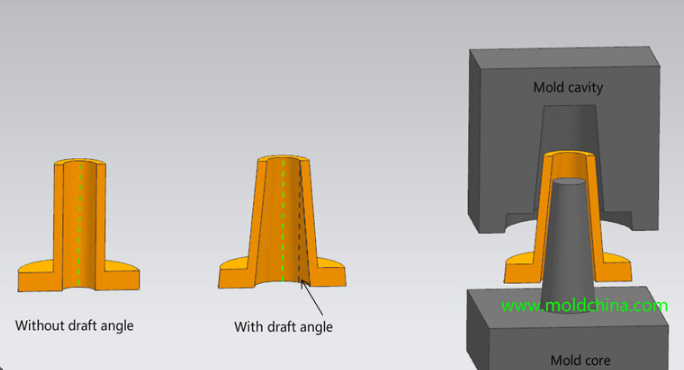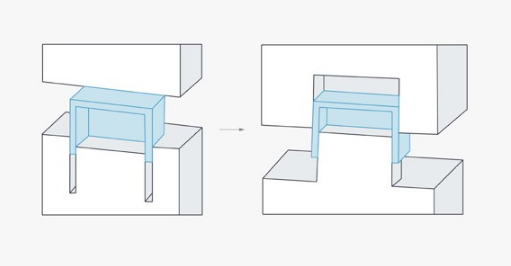The required draft angle typically ranges from 0.5° to 2°, varying with part design and material.
Fundamentals of Draft Angles in Injection Molding
Understanding the fundamentals of draft angles is crucial in the injection molding process, as they play a key role in the quality and manufacturability of the molded parts.

Definition and Importance of Draft Angles
What is a Draft Angle?
Definition: A draft angle is a slight taper applied to the vertical surfaces of a mold. It allows easier ejection of the molded part from the mold.
Importance: Without adequate draft angles, parts may stick to the mold, leading to damage or deformation upon ejection. It also prevents scratches and improves the surface finish of the molded part.
Impact on Manufacturing Process:
Ejection Efficiency: Proper draft angles ensure faster and smoother ejection, reducing cycle times and improving overall efficiency.
Tooling Lifespan: Adequate draft angles reduce wear on the mold, enhancing its longevity and reducing maintenance costs.
Standard Draft Angle Measurements
General Guidelines:
Typical Values: Standard draft angles range from 0.5° to 2° for most materials. However, deeper cavities may require larger angles, up to 5° or more.
Material Dependency: Softer materials like TPE may need larger draft angles (around 3° to 5°), while rigid materials like polycarbonate can often be ejected with smaller angles (as low as 0.5°).
Part Design Considerations:
Surface Texture: Heavily textured surfaces require larger draft angles, typically an additional 1° to 2° per 0.025 mm of texture depth.
Geometry of the Part: Complex geometries with deep cavities or undercuts might require varying draft angles on different sections of the mold to facilitate proper ejection.
For further exploration on this topic, the Wikipedia page on Injection Molding offers additional insights.
Determining the Optimal Draft Angle
Selecting the optimal draft angle in injection molding is a critical decision that impacts the moldability and quality of the final product. This selection is influenced by various factors, including material properties and part design.
Factors Influencing Draft Angle Selection
Design Complexity:
Deep Cavities and Undercuts: Require larger draft angles, sometimes exceeding 5°, to prevent part sticking and facilitate ejection.
Textured Surfaces: Heavily textured surfaces need additional draft, typically 1° to 2° extra per 0.025 mm of texture depth, to avoid damage during ejection.
Mold Design:
Mold Size: Larger molds, due to their expanded surface area, might need slightly greater draft angles to counteract increased friction during ejection.
Ejection Mechanism: The type of ejection system used (such as pins or sleeves) can also dictate the necessary draft angle. Ejection mechanisms that apply uneven forces may require larger draft angles to ensure smooth release.
Material-Specific Draft Angle Considerations
Thermoplastics:
ABS and Polycarbonate: Generally require smaller draft angles, around 0.5° to 1.5°, due to their rigid nature.
TPE and Silicone: Softer, more flexible materials often need larger draft angles, in the range of 3° to 5°, to prevent sticking and tearing.
Thermosets and High-Temperature Materials:
High-Performance Polymers: Materials like PEEK and PSU, which undergo high-temperature processing, might require draft angles tailored to their specific shrinkage and thermal expansion properties.
Cost Implications:
Material Costs: Using materials that require larger draft angles can indirectly increase the material cost, as more material is needed to accommodate the draft.
Tooling Costs: Designing molds with varying or larger draft angles can increase tooling costs by up to 20%, depending on the complexity.
For more detailed information on this subject, the Wikipedia page on Injection Molding provides valuable insights.
Draft Angles and Part Design
Draft angles in injection molding are crucial for both the functionality and aesthetics of the final product. Implementing them effectively requires a careful balance between technical requirements and design aspirations.

Impact of Draft Angles on Part Aesthetics
Visual Influence:
Taper Appearance: Draft angles introduce a taper, often between 0.5° to 2°, subtly affecting the part’s visual profile. This taper needs careful consideration in visible areas to maintain aesthetic appeal.
Texture Depth Perception: For textured surfaces, a draft angle of 1° to 2° per 0.025 mm of texture depth might change the texture’s perceived depth and feel.
Functionality and Dimensional Accuracy:
Assembly Compatibility: Parts intended to fit together require draft angles that complement each other, especially for precision assemblies.
Dimensional Adjustments: Even a small draft angle can alter a part’s dimensions. For example, a 1° draft over a 100 mm length can change the width by approximately 1.75 mm.
Design Strategies for Effective Draft Angles
Aesthetic and Functional Balance:
Minimizing Visual Impact: Placing draft angles strategically on non-focal areas can preserve the part’s visual integrity.
Consistency in Design: Applying draft angles uniformly across parts ensures a cohesive and intentional design look.
Integrative Design Techniques:
Early Implementation: Incorporating draft angles in the initial design stage can avoid the need for redesigns, which can increase project costs by up to 30%.
CAD Simulations: Utilizing CAD tools to visualize draft angle effects helps in making informed design decisions, potentially reducing trial and error iterations by 25-40%.
Cost and Manufacturing Efficiency:
Mold Design Complexity: Complex draft angle designs can increase mold manufacturing costs by 15-20%.
Material Use Optimization: Efficient draft angle design can decrease material waste by up to 10%, contributing to both cost reduction and environmental sustainability.
Explore more about this topic on the Injection Molding Wikipedia page for further details.
Technical Challenges with Draft Angles
In injection molding, draft angles present unique technical challenges, especially when dealing with undercuts and complex geometries or balancing them with mold ejection. The following table outlines these challenges and the strategies to address them.
| Challenge | Description | Implications | Solutions | Cost/Time Impact |
|---|---|---|---|---|
| Overcoming Undercuts and Complex Geometries | Undercuts and complex shapes hinder smooth ejection. | Increased risk of part damage or mold wear. | Use of side-actions or collapsible cores in molds. | Can increase mold cost by 20-30%, and cycle time by 10-15%. |
| Balancing Draft Angles and Mold Ejection | Adequate draft angles are needed to prevent sticking. | Inadequate draft angles lead to difficult ejection and potential part damage. | Optimizing draft angle for each material and part geometry. | May extend the design phase by 5-10%, but reduces ejection-related defects by up to 50%. |
Overcoming Undercuts and Complex Geometries
Challenge: Undercuts and complex geometries can make it difficult to eject the part from the mold without damage.
Solution: Utilize advanced mold designs with side-actions or collapsible cores to accommodate these features.
Cost/Time Impact: These mold modifications can increase the overall mold cost by 20-30% and add 10-15% more time to the molding cycle.
Balancing Draft Angles and Mold Ejection
Challenge: Draft angles must be optimized to ensure easy ejection without compromising the part’s integrity.
Solution: Careful analysis and adjustment of draft angles for each specific material and part geometry are required.
Cost/Time Impact: This optimization might extend the design phase by 5-10%, but it significantly reduces ejection-related defects, potentially by up to 50%.
Addressing these challenges effectively ensures the high quality of the final product while maintaining the efficiency of the injection molding process.
For more comprehensive information, refer to the Injection Molding Wikipedia page.




